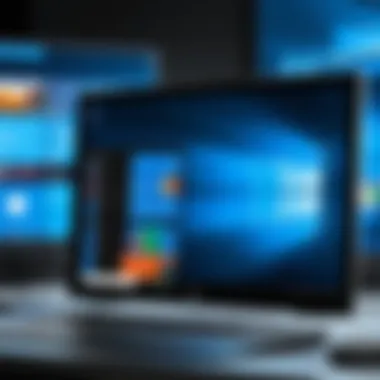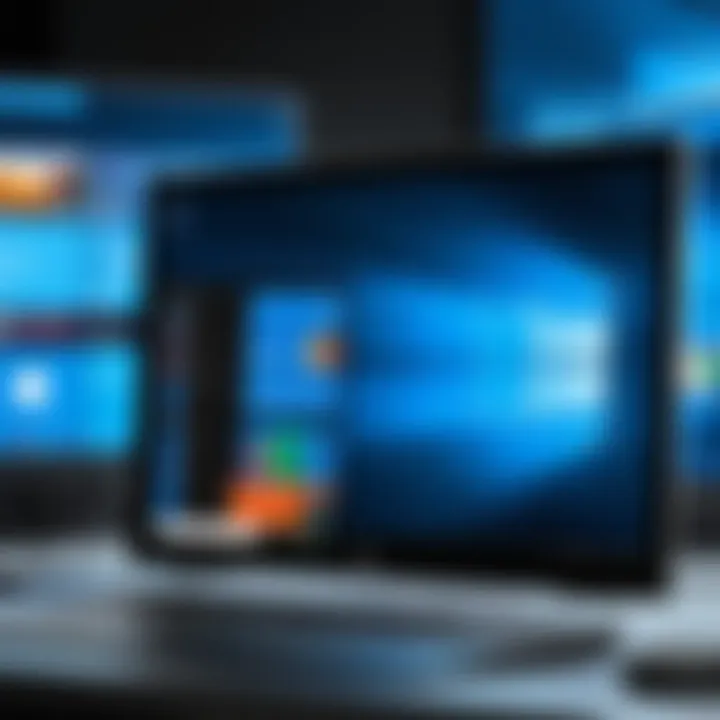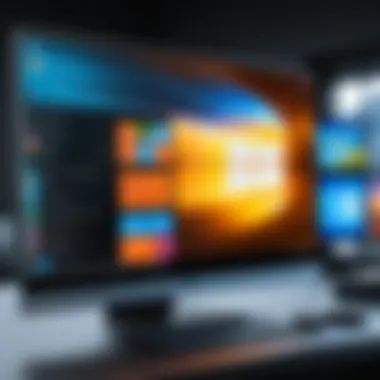Upgrade from Windows Home to Windows 10 Pro: Complete Guide


Intro
Upgrading from Windows Home to Windows 10 Pro is a significant step for many users, particularly those who seek enhanced functionality and better security features. This transition can offer various benefits, making it an attractive option for tech-savvy individuals. Understanding the reasons for this upgrade, the requirements, and the entire process can greatly influence the experience.
Product Overview
Prelims to Windows Pro
Windows 10 Pro builds upon the foundations established in Windows Home. Designed for both professionals and advanced users, it brings additional features that cater to their specific needs. This version includes enhanced security, management, and productivity tools that are absent in the Home edition. Whether for business or personal usage, Windows 10 Pro offers an array of capabilities that facilitate troubleshooting, data protection, and overall system efficiency.
Key Features and Specifications
Some notable features include:
- BitLocker Drive Encryption: Protects data from unauthorized access.
- Group Policy Management: Allows users to manage multiple devices more effectively.
- Remote Desktop: Provides access to a desktop from anywhere, an essential for mobile work.
- Enterprise Mode Internet Explorer: Enhances compatibility with older applications.
These features create a more flexible and robust environment compared to Windows Home, permitting users to maximize their hardware’s potential and ensure data safety.
Performance and User Experience
Hands-on Testing and Evaluation
In practical applications, Windows 10 Pro demonstrates significant improvements in performance. The boot-up time is typically faster, and applications run smoothly, even under heavy loads. Users report a positive experience with reduced latency when accessing files or connecting to remote servers.
User Interface and Ease of Use
The interface remains largely the same as Windows Home, which eases the transition for users. However, the additional features are intuitively placed, allowing users to adapt quickly without a steep learning curve.
Comparison with Similar Products
When viewed alongside other operating systems such as macOS or Linux distributions, Windows 10 Pro stands out due to its unique feature set tailored for business use, including seamless compatibility with many enterprise applications and superior hardware support.
Design and Build Quality
Detailed Analysis of Design Elements
The aesthetics of Windows 10 Pro are consistent with its predecessors. The start menu is customizable, and the focus on user experience highlights the importance of accessibility. Many of the graphical updates contribute to a more modern and professional appearance.
Materials Used and Durability
While the operating system primarily operates in the digital space, its resilience against performance degradation over time makes it a robust choice. Regular updates from Microsoft ensure that the system remains stable and secure, adapting to new technologies as they emerge.
Ergonomics and Aesthetics
Windows 10 Pro maintains a user-friendly design. The outlay of the features promotes efficiency, allowing users to access tools like the Task View and virtual desktops with minimal effort.
Technology and Innovation
Groundbreaking Technologies
One significant advancement is the introduction of Windows Hello, a biometric security feature that significantly enhances user security through facial recognition or fingerprint scanning. This feature not only makes logging in easier but also more secure.
Potential Impact on the Industry
This upgrade addresses the increasing need for security in personal and professional computing. With rising cyber threats, the implementation of features like BitLocker signifies a proactive approach by Microsoft towards data security.
Future Trends
As consumer needs evolve, future iterations of Windows may integrate more artificial intelligence (AI) capabilities and seamless cloud integration, allowing users to synchronize data across devices effortlessly.
Pricing and Value Proposition
Pricing Details
Upgrading to Windows 10 Pro typically costs around $139.99 USD. While it may seem steep compared to the Home version, the added features present a more appealing value proposition for users requiring advanced functionalities.
Comparison with Competitors
In terms of value, Windows 10 Pro competes effectively against operating systems like macOS, particularly for users who require compatibility with specific software critical for business operations.
Recommendations and Final Verdict
Understanding Windows Home and Windows Pro


When considering an upgrade from Windows Home to Windows 10 Pro, it is essential to understand the core differences between these two operating systems. Each version serves different user needs, and recognizing this helps determine the right path for your computing requirements.
Overview of Windows Home
Windows Home is primarily designed for average consumers. It offers a user-friendly experience aimed at providing all the fundamental features necessary for daily tasks. Key functionalities include browsing the internet, using productivity software, and connecting to other devices. The interface is straightforward, which works well for non-technical users. However, advanced features like group policy management and BitLocker encryption are not included in this version, limiting its appeal for professional or power users.
Key Features of Windows Pro
Windows 10 Pro provides additional functionalities that cater to business and advanced home users. Some of the standout features include:
- BitLocker Encryption: This tool secures data on the device, providing a level of protection that is vital for sensitive information.
- Group Policy Management: This allows for better control over configurations and settings across multiple systems within an organization.
- Remote Desktop: Users can connect to their PCs remotely, offering flexibility in access.
- Windows Update for Business: This feature provides more control over update timings, which is crucial for maintaining system stability in professional environments.
These features enable users to manage their systems more effectively and securely, making Windows 10 Pro a more powerful platform for those that demand more from their operating system.
Differences between Windows Home and Pro
Understanding the differences between Windows Home and Windows 10 Pro is key before upgrading. Here are the main distinctions:
- Target Audience: Windows Home targets casual users, while Windows 10 Pro is geared towards professionals and businesses.
- Security Features: Pro includes advanced security measures like BitLocker, which are absent in the Home version.
- Management Tools: Pro has tools for IT management, which are not needed in casual home use.
- Customization and Control: Users of Windows 10 Pro have greater control over system settings and policies compared to those using Windows Home.
In summary, understanding these aspects provides clarity on whether an upgrade is appropriate and beneficial, paving the way for a tailored user experience.
Reasons to Upgrade to Windows Pro
Upgrading from Windows Home to Windows 10 Pro can be a significant decision for users seeking improve stability and functionality of their operating system. While Windows Home caters to basic users, Windows 10 Pro offers more advanced features that can enhance productivity and protect sensitive information. This section explores the critical factors that make the upgrade worthwhile and provides insight into why tech-savvy individuals might consider this transition.
Enhanced Security Features
One of the primary motivations for moving to Windows 10 Pro is its superior security offerings. Windows 10 Pro includes features that are not present in the Home edition, making it more suitable for business users or anyone who manages sensitive data. For instance, BitLocker encryption helps protect your data on hard drives and removable storage devices. This feature ensures that even if your device is lost or stolen, unauthorized users cannot access your files.
Additionally, Windows 10 Pro comes with Windows Defender Credential Guard, which provides an additional layer of protection for user credentials. Furthermore, it supports advanced features like Windows Information Protection (WIP), which helps keep corporate data secure on employee-owned devices. These enhancements are critical for users who may face cyber threats or unauthorized access to their systems.
Key Benefits of Enhanced Security:
- Data Protection: BitLocker encryption secures your data.
- Credential Guard: Protects sensitive user credentials.
- Threat Mitigation: Advanced security tools help avert attacks.
Advanced Management Tools
The advanced management tools available in Windows 10 Pro provide significant advantages for users dealing with multiple devices or networks. Features such as Group Policy support enable easier configuration and management of system settings across an organization. This is especially useful for IT managers looking to maintain uniformity and security across an enterprise.
Moreover, Windows 10 Pro allows for remote desktop functionality. This means users can access their desktops remotely, which is invaluable for those who work from various locations or need to manage tasks without being physically present at their workstations.
Tools and Features for Management:
- Group Policy: Helps enforce and set rules for multiple devices.
- Remote Desktop: Access your desktop from anywhere.
- Enterprise Mode Internet Explorer: Provides compatibility for legacy applications.
Support for Virtualization
Another compelling reason to upgrade is the support for virtualization technologies that Windows 10 Pro offers. Users can leverage Hyper-V, a built-in virtualization platform that allows them to create and run virtual machines on their systems. This is beneficial for developers and testers who need different environments for application testing.
Virtualization can also streamline software development and deployment. Users can quickly switch between different operating systems or application setups without the need for multiple physical machines. This can potentially increase productivity and reduce costs associated with IT infrastructure.
Advantages of Virtualization:
- Hyper-V Integration: Create and manage virtual machines easily.
- Resource Efficiency: Run multiple environments on a single machine.
- Development Flexibility: Test applications in various configurations.
In summary, the reasons to upgrade to Windows 10 Pro cover critical aspects of security, management, and virtualization. The decision might vary based on individual needs, but Pro offers distinct advantages that make it a worthy consideration for users looking to enhance their computing experience.
Prerequisites for the Upgrade
Before diving into the upgrade process from Windows Home to Windows 10 Pro, it is essential to understand the prerequisites necessary for a seamless transition. This section will address the system requirements that your hardware must meet, the crucial backup procedures to follow, and how to verify your current version of Windows. Ensuring these steps are properly executed can enhance the upgrade experience and mitigate potential challenges.
System Requirements
To successfully upgrade to Windows 10 Pro, your PC must meet specific system requirements. These requirements ensure that the new operating system runs effectively and that you can take full advantage of the features offered by the Pro edition. Here are the basic requirements:
- Processor: 1 GHz or faster with at least two cores on a compatible 64-bit processor or system on a chip (SoC).
- RAM: A minimum of 4GB of RAM is necessary for smooth operation.
- Storage: At least 64GB of available storage is required for the installation.
- Graphics card: DirectX 9 or later with a WDDM 1.0 driver.
- Display: A display greater than 800 x 600 resolution.
- Internet connection: Required for updates, and some features may also require an internet connection.
Meeting these criteria is crucial for the upgrade process to be successful. If your hardware does not meet these specifications, you may encounter performance issues or failed installations. Double-checking components before proceeding can save considerable time and frustration.
Backup Procedures
Backing up your data before an operating system upgrade is vital. Microsoft strongly recommends creating a backup for several reasons. First, it protects your files from any unforeseen problems that may occur during the upgrade process. Second, it allows you to have a fallback option should the installation not proceed as expected. Here are some recommended backup procedures:
- Use Windows Backup and Restore: You can access this by searching for "Backup" in the Windows Control Panel. Setting up a full backup of your files will safeguard your important data.
- Cloud Storage Solutions: Consider utilizing services like OneDrive or Google Drive to store essential files securely online. This approach ensures your data is accessible from other devices.
- Create a System Image: A system image backup is a complete copy of your current operating system. This can be done through the Control Panel or using tools like Macrium Reflect.
- External Hard Drive: Copy critical files to an external hard drive. This provides a physical backup that is independent of your computer’s operating system.


By following these backup procedures, you can avoid significant data loss during the upgrade. This step is non-negotiable for anyone looking to upgrade.
Check Current Version
Before starting the upgrade, knowing your current version of Windows is essential. This information not only helps you understand the available upgrade options but also provides insight into the specific features you may gain or lose during the transition. To check your current version, follow these steps:
- Press the Windows key + R to open the Run dialog box.
- Type and hit Enter.
- A window will display your Windows version along with the build number.
This step allows you to confirm you are running a compatible Windows Home version for the upgrade. If you find that you are on an unsupported build, you may need to update before proceeding.
Having a clear understanding of these prerequisites ensures that you are well-prepared for the upgrade to Windows 10 Pro. This preparation is key to a smooth and successful transition.
The Upgrade Process
The upgrade process is a crucial component of transitioning from Windows Home to Windows 10 Pro. Understanding this process helps users to navigate the various steps involved efficiently. It can enhance system functionalities and access to advanced features. Encapsulating the upgrade process allows users to appreciate its benefits, such as improved security, management capabilities, and overall performance enhancements.
This section will provide insights on different avenues available for upgrading, the acquisition of licenses, and tools that aid in a smoother transition. Being equipped with detailed information ensures users can plan and execute the upgrade successfully.
Options for Upgrading
When it comes to upgrading from Windows Home to Windows 10 Pro, users can choose from several options. These pathways can significantly influence the smoothness of the upgrade experience. The predominant upgrade methods include:
- Windows Store: Users can purchase the upgrade directly from the Microsoft Store through their system.
- Retail Purchase: Physical or digital copies of Windows 10 Pro can be bought from authorized retailers or online platforms.
- License Key: If users have an unused Windows 10 Pro key, they can enter this key directly to initiate the upgrade.
Each option carries its own sets of advantages and potential drawbacks. Choosing the right method is important for ensuring user needs and preferences are met effectively.
Purchasing a Windows Pro License
Acquiring a Windows 10 Pro license is a fundamental step in the upgrade journey. When purchasing, users should consider where to acquire this license. Options include:
- Microsoft Store: A straightforward choice, it allows users to buy licenses digitally. This ensures users have the latest updates and security patches.
- Retailers: Many authorized retailers sell Windows 10 Pro. It may be useful to compare prices and check for offers.
- Online Marketplaces: Caution is advised here. Purchasing from legitimate sites ensures the license's validity and prevents potential issues in the future.
Before buying a license, verifying that it is compatible with the existing Windows system is essential. Ensuring the license aligns with the desired upgrade path helps in avoiding activation problems later.
Using the Windows Upgrade Assistant
The Windows Upgrade Assistant is a valuable tool provided by Microsoft to facilitate the upgrade process. It stands out for its ease of use and comprehensive support. Users can either find it directly through the Microsoft website or access it through the Windows operating system settings.
Using this tool typically involves the following steps:
- Download: Visit the official Microsoft website to download the Windows Upgrade Assistant.
- Run the Tool: Launch the assistant, which will check for system compatibility with Windows 10 Pro.
- Follow Instructions: The tool provides a guided interface to help users with each step, making the upgrading process user-friendly.
- Installation: Upon completion of the checks, users can proceed with the installation directly through the assistant.
The Upgrade Assistant helps in simplifying the experience, reducing the chances of errors during the upgrade process.
"Being prepared and informed is key to ensuring a seamless transition to a more powerful operating system."
In summary, understanding the upgrade process and options is vital for a successful upgrade from Windows Home to Windows 10 Pro. Having clarity on the methods of upgrading, where to purchase licenses, and how to utilize provided tools makes the transition smoother. With the right preparatory measures, users can invigorate their computing experience effectively.
Step-by-Step Upgrade Instructions
Upgrading from Windows Home to Windows 10 Pro involves several key actions that must be executed correctly to ensure the transition is smooth. This section provides a detailed roadmap, allowing the user to navigate the upgrade with clarity and confidence. Accomplishing each step is essential for leveraging the full potential of Windows 10 Pro, which includes enhanced functionality and robust security features. Being methodical during the process reduces the risk of errors and aids in troubleshooting should issues arise.
Initiating the Upgrade
To begin the upgrade, the user must ensure their system is ready. First, check if you are running an eligible version of Windows Home. If your hardware meets the system requirements previously outlined in the article, the process can proceed. Users should locate the Windows Settings menu. This can be done by clicking on the Start menu and then selecting the gear icon, which opens the settings interface.
Once there, proceed to the "Update & Security" tab and navigate to the "Activation" subsection. Here, you will find the option to upgrade to Windows 10 Pro. This choice initiates the upgrade process, validating your current installation and preparing for the transition. The user is prompted to purchase a license if one is not already available, which leads into the next key step.
Entering the Product Key
Entering the product key correctly is vital for unlocking the upgraded features of Windows 10 Pro. After selecting the option to upgrade, a window will appear asking for the 25-character product key. This key is often found on the documentation or email associated with your purchase of Windows 10 Pro.
It is important to input the product key without errors. If mistakes occur, activation will fail, and a frustrating experience may ensue. Ensure to double-check the key for any typing mistakes. Upon successful entry, the system will validate the key and begin the transition to Windows 10 Pro. The user will be informed of the progress and expected time for completion.
Completing the Installation
The final stage of the upgrade involves the installation of Windows 10 Pro. Once the product key is validated, the system will download necessary files. This download may take some time depending on your internet connection.
After downloading, the installation will commence. During this phase, the computer will restart multiple times. It is important not to interrupt this process; allow the system to handle updates and configurations. After the installation is complete, the user will be greeted with the Windows setup screen, guiding them through the completion of their new operating environment.
Once finished, the system will prompt for a final set of preferences. At this point, you can settle into your enhanced Windows 10 Pro experience and begin to explore its new features.
"A careful approach during the upgrade process minimizes complications, ensuring users can enjoy their new operating system benefits without delay."


Without neglecting the importance of these steps, following this guide will lead to a seamless transition from Windows Home to Windows 10 Pro.
Post-Upgrade Considerations
After successfully upgrading from Windows Home to Windows 10 Pro, it is essential to assess and optimize the system to fully leverage the new capabilities. This phase plays a critical role in ensuring a smooth transition and confirming that the upgrade meets the user's expectations and requirements. Some specific elements to consider post-upgrade include verifying the installation, updating necessary drivers and software, and exploring the enhanced features unique to Windows 10 Pro.
Verifying Successful Installation
Verifying that the upgrade was successful is crucial for peace of mind and functionality. The process begins by confirming the edition of Windows installed. To check this:
- Click on the Start button.
- Select Settings.
- Navigate to System and then click on About.
In the About section, under Windows specifications, ensure it states Windows 10 Pro. If this is confirmed, the upgrade was successful. Additionally, check for any error messages that may have occurred during installation. Recognizing these issues early on can prevent larger problems later.
"Knowing your system is operating at its full potential is vital for productivity and stability."
Updating Drivers and Software
Once the successful installation is confirmed, updating drivers and software is next. Drivers, which are integral for hardware communication, often require updates after a significant operating system upgrade. Neglecting this step may lead to performance issues or incompatibilities. Here are steps to update your drivers:
- Use Device Manager: Right-click on the Start button and choose Device Manager. Check if any devices have a yellow triangle icon indicating problems. Right-click and select Update driver for those devices.
- Windows Update: Go to Settings > Update & Security > Windows Update. Click on Check for updates to install any available updates.
Along with drivers, third-party software should be updated as well, particularly security software and applications that utilize advanced features in Windows 10 Pro. This helps ensure compatibility and enhances overall system security.
Exploring New Features and Settings
Windows 10 Pro introduces various features not available in Windows Home which are worth exploring. Understanding the new capabilities can improve user experience and efficiency. Key features to consider include:
- BitLocker: Provides full disk encryption, enhancing security for sensitive data.
- Remote Desktop: Useful for accessing your computer remotely, ideal for tech-savvy individuals needing flexibility.
- Group Policy Management: Allows advanced management of settings and deployment across devices, particularly useful for users in professional or organizational settings.
To explore these features, navigate to the Settings panel and familiarize yourself with options under Update & Security and System. This will empower you to utilize all the tools available in Windows 10 Pro effectively.
Common Issues and Solutions
In the process of upgrading from Windows Home to Windows 10 Pro, users may encounter several issues. Recognizing and addressing these issues can be crucial to ensure a smooth transition. This section covers common problems such as installation errors, activation challenges, and performance issues post-upgrade. Understanding these aspects helps users not only to troubleshoot effectively but also to optimize their overall experience with Windows 10 Pro.
Troubleshooting Installation Errors
Installation errors can arise for various reasons, including system incompatibilities or connectivity issues. Here are some common installation errors you may face and how to resolve them:
- Error Codes: Familiarize yourself with error codes like 0xC1900101, which is tied to driver issues. Research these codes to understand what they signify.
- Clean Boot: Before starting the upgrade, perform a clean boot. This helps to eliminate third-party software conflicts that could hinder the installation process.
- Windows Update: Ensure that all updates are downloaded and installed on your current version. Missing updates can lead to installation failure.
- Disk Space: Lack of adequate disk space can also create problems. Always verify that there is sufficient space on your hard drive, typically around 20 GB or more.
If you encounter a particularly stubborn error, detailed guides available on specialized forums like Reddit can be invaluable.
Activation Problems
After a successful installation, some users might struggle with activation issues. Here’s how to address common activation hurdles:
- Product Key Verification: Double-check the product key entered. Ensure that it corresponds to a valid Windows 10 Pro license.
- Internet Connectivity: Ensure you are connected to the internet, as activation requires online services.
- Windows Activation Tool: You can use the built-in Windows Activation Troubleshooter found in Settings under Updates & Security. This tool can often resolve minor issues automatically.
If problems persist, reaching out to Microsoft Support might be necessary. They can provide guidance specific to your situation.
Performance Issues After Upgrade
After upgrading, some users might notice a dip in system performance. Here are some solutions to consider:
- Driver Updates: Update all necessary drivers. Newer versions can improve compatibility with Windows 10 Pro.
- Startup Programs: Disable unnecessary startup programs. This can help speed up boot time and overall system performance.
- Windows Optimization: Utilize the built-in optimization tools in Windows 10 Pro to fine-tune your system settings.
Sometimes, a fresh reinstall of certain applications can help in resolving lingering performance issues. Be patient, as some adjustment time may be required for settings to align with your system’s new capabilities.
By effectively managing these common issues, users can significantly enhance their experience with Windows 10 Pro. Addressing concerns proactively allows for a richer and more efficient use of the upgraded operating system.
End
In the journey of enhancing computing experiences, upgrading from Windows Home to Windows 10 Pro stands as a significant milestone. This upgrade is not merely a change in the operating system; it represents a shift towards greater productivity, security, and capability.
For individuals and businesses alike, Windows 10 Pro offers essential features that cater to more advanced needs. The increased security protocols provide peace of mind when dealing with sensitive data. Advanced management tools streamline operations, facilitating multitasking and organization.
Final Thoughts on the Upgrade
Transitioning to Windows 10 Pro can seem daunting, yet the benefits outweigh the initial concerns. Users gain the ability to utilize functionalities such as Group Policy Management, BitLocker Drive Encryption, and the Remote Desktop feature. These enhancements can lead to noticeable improvements in operational efficiency and data protection. Moreover, the ecosystem of productivity tools integrated within Windows 10 Pro supports collaboration and remote work, which has become vital in today’s work environment.
"Upgrading not only unlocks features but also positions users to excel in a rapidly evolving digital landscape."
Future Considerations for Windows Users
As the technology landscape continues to evolve, keeping Windows 10 Pro updated is crucial. Microsoft frequently releases updates that introduce new features, security patches, and performance enhancements. Users must familiarize themselves with the update process and be proactive in maintaining their systems.
Furthermore, considering potential integrations with cloud services could expand usability. Windows 10 Pro’s compatibility with various software solutions allows users to leverage cloud storage for enhanced accessibility and backup options. Staying informed about the latest trends and features can ensure that users maximize their investment in this operating system.
Overall, monitoring advancements, exploring compatibility options, and remaining adaptive to new tools will serve Windows 10 Pro users well in the ever-changing realm of technology.

